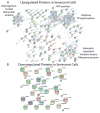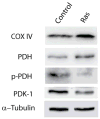Oncogene-induced cellular senescence elicits an anti-Warburg effect
- PMID: 23798001
- PMCID: PMC3867201
- DOI: 10.1002/pmic.201200298
Oncogene-induced cellular senescence elicits an anti-Warburg effect
Abstract
Cellular senescence, an irreversible cell cycle arrest induced by a diversity of stimuli, has been considered as an innate tumor suppressing mechanism with implications and applications in cancer therapy. Using a targeted proteomics approach, we show that fibroblasts induced into senescence by expression of oncogenic Ras exhibit a decrease of global acetylation on all core histones, consistent with formation of senescence-associated heterochromatic foci. We also detected clear increases in repressive markers (e.g. >50% elevation of H3K27me2/3) along with decreases in histone marks associated with increased transcriptional expression/elongation (e.g. H3K36me2/3). Despite the increases in repressive marks of chromatin, 179 loci (of 2206 total) were found to be upregulated by global quantitative proteomics. The changes in the cytosolic proteome indicated an upregulation of mitochondrial proteins and downregulation of proteins involved in glycolysis. These alterations in primary metabolism are opposite to the well-known Warburg effect observed in cancer cells. This study significantly improves our understanding of stress-induced senescence and provides a potential application for triggering it in antiproliferative strategies that target the primary metabolism in cancer cells.
Keywords: Cell biology; Histones; Metabolism; Oxidative phosphorylation; Senescence.
© 2013 WILEY-VCH Verlag GmbH & Co. KGaA, Weinheim.
Conflict of interest statement
The authors declare no conflict of interest.
Figures
Comment in
-
Oncogene-induced cellular senescence elicits an anti-Warburg effect.Proteomics. 2013 Sep;13(17):2542-3. doi: 10.1002/pmic.201300335. Proteomics. 2013. PMID: 23922328
Similar articles
-
Oncogene-induced cellular senescence elicits an anti-Warburg effect.Proteomics. 2013 Sep;13(17):2542-3. doi: 10.1002/pmic.201300335. Proteomics. 2013. PMID: 23922328
-
Detection of the Ubiquitinome in Cells Undergoing Oncogene-Induced Senescence.Methods Mol Biol. 2017;1534:127-137. doi: 10.1007/978-1-4939-6670-7_12. Methods Mol Biol. 2017. PMID: 27812874 Free PMC article.
-
Proteomic analysis reveals novel common genes modulated in both replicative and stress-induced senescence.J Proteomics. 2015 Oct 14;128:18-29. doi: 10.1016/j.jprot.2015.07.010. Epub 2015 Jul 20. J Proteomics. 2015. PMID: 26206181
-
Fluorescence-based detection and quantification of features of cellular senescence.Methods Cell Biol. 2011;103:149-88. doi: 10.1016/B978-0-12-385493-3.00007-3. Methods Cell Biol. 2011. PMID: 21722803 Review.
-
Oncogene-induced senescence: From biology to therapy.Mech Ageing Dev. 2020 Apr;187:111229. doi: 10.1016/j.mad.2020.111229. Epub 2020 Mar 18. Mech Ageing Dev. 2020. PMID: 32171687 Review.
Cited by
-
Brain Senescence Caused by Elevated Levels of Reactive Metabolite Methylglyoxal on D-Galactose-Induced Aging Mice.Front Neurosci. 2019 Sep 18;13:1004. doi: 10.3389/fnins.2019.01004. eCollection 2019. Front Neurosci. 2019. PMID: 31619960 Free PMC article.
-
Metformin effects on head and neck squamous carcinoma microenvironment: Window of opportunity trial.Laryngoscope. 2017 Aug;127(8):1808-1815. doi: 10.1002/lary.26489. Epub 2017 Feb 10. Laryngoscope. 2017. PMID: 28185288 Free PMC article. Clinical Trial.
-
Metabolic stress is a barrier to Epstein-Barr virus-mediated B-cell immortalization.Proc Natl Acad Sci U S A. 2016 Feb 9;113(6):E782-90. doi: 10.1073/pnas.1517141113. Epub 2016 Jan 22. Proc Natl Acad Sci U S A. 2016. PMID: 26802124 Free PMC article.
-
Cellular aging beyond cellular senescence: Markers of senescence prior to cell cycle arrest in vitro and in vivo.Aging Cell. 2021 Apr;20(4):e13338. doi: 10.1111/acel.13338. Epub 2021 Mar 12. Aging Cell. 2021. PMID: 33711211 Free PMC article. Review.
-
Metabolic alterations accompanying oncogene-induced senescence.Mol Cell Oncol. 2014 Dec 23;1(3):e963481. doi: 10.4161/23723548.2014.963481. eCollection 2014 Jul-Sep. Mol Cell Oncol. 2014. PMID: 27308349 Free PMC article. Review.
References
-
- Lowe SW, Cepero E, Evan G. Intrinsic tumour suppression. Nature. 2004;432:307–315. - PubMed
-
- Hayflick L. LIMITED IN VITRO LIFETIME OF HUMAN DIPLOID CELL STRAINS. Experimental Cell Research. 1965;37:614. - PubMed
-
- Wright WE, Shay JW. Telomere dynamics in cancer progression and prevention: fundamental differences in human and mouse telomere biology. Nature Medicine. 2000;6:849–851. - PubMed
-
- Chiantore MV, Vannucchi S, Mangino G, Percario ZA, et al. Senescence and Cell Death Pathways and Their Role in Cancer Therapeutic Outcome. Current Medicinal Chemistry. 2009;16:287–300. - PubMed
-
- Shay JW, Roninson IB. Hallmarks of senescence in carcinogenesis and cancer therapy. Oncogene. 2004;23:2919–2933. - PubMed
Publication types
MeSH terms
Substances
Grants and funding
LinkOut - more resources
Full Text Sources
Other Literature Sources








